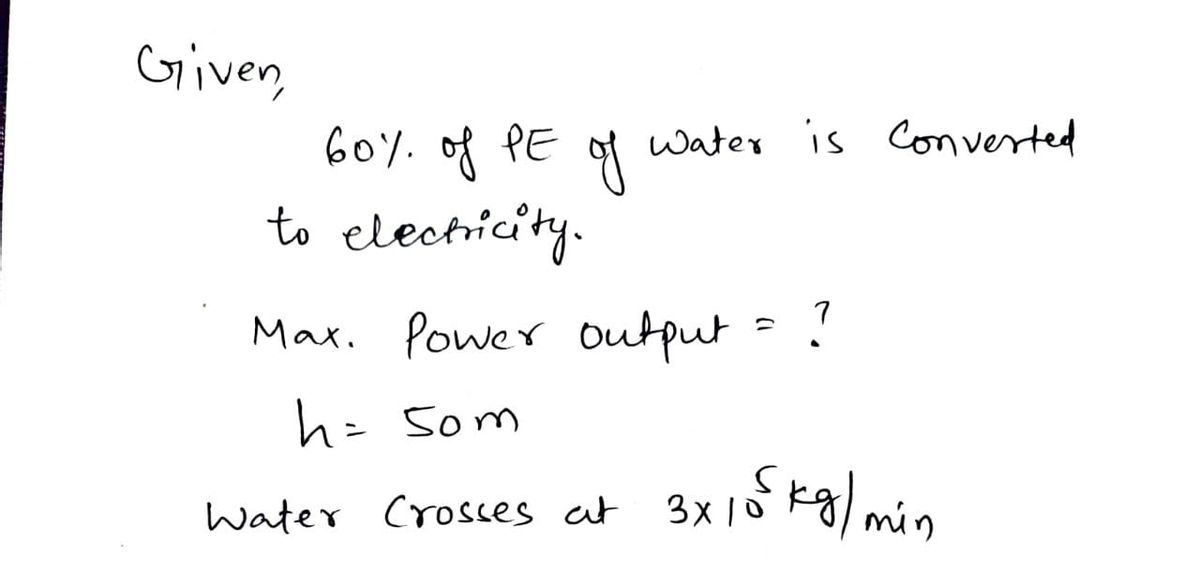If 60 percent of the potential energy of water flowing over a dam can be converted to electricity, find the maximum power output, in kW (kilowatts), for a dam 50 m high where the water crosses at a rate of 300,000 kg/min (1 watt = 1 joule/sec, 1 kW = 1000 watts)
If 60 percent of the potential energy of water flowing over a dam can be converted to electricity, find the maximum power output, in kW (kilowatts), for a dam 50 m high where the water crosses at a rate of 300,000 kg/min (1 watt = 1 joule/sec, 1 kW = 1000 watts)
College Physics
11th Edition
ISBN:9781305952300
Author:Raymond A. Serway, Chris Vuille
Publisher:Raymond A. Serway, Chris Vuille
Chapter1: Units, Trigonometry. And Vectors
Section: Chapter Questions
Problem 1CQ: Estimate the order of magnitude of the length, in meters, of each of the following; (a) a mouse, (b)...
Related questions
Question
20. If 60 percent of the potential energy of water flowing over a dam can be converted to electricity, find the maximum power output, in kW (kilowatts), for a dam 50 m high where the water crosses at a rate of 300,000 kg/min
(1 watt = 1 joule/sec, 1 kW = 1000 watts)
![### Key Physics Formulas
1. **Average Speed**:
\[
v = \frac{d}{t}
\]
- **Explanation**: The average speed is calculated as the distance traveled (d) divided by the time taken (t).
2. **Distance Under Acceleration**:
\[
d = v_0 t + \frac{1}{2} a t^2
\]
- **Explanation**: This formula calculates the distance (d) covered under uniform acceleration. \(v_0\) is the initial velocity, \(a\) is the acceleration, and \(t\) is the time.
3. **Weight**:
\[
W = mg
\]
- **Explanation**: Weight (W) is the force exerted by gravity on a mass (m), where \(g\) is the acceleration due to gravity.
4. **Acceleration**:
\[
a = \frac{F_{\text{net}}}{m}
\]
- **Explanation**: Acceleration (a) is the net force (\(F_{\text{net}}\)) acting on an object divided by its mass (m).
5. **Gravity Law**:
\[
F = \frac{G m_1 m_2}{r^2}
\]
- **Explanation**: This formula describes the gravitational force (F) between two masses (\(m_1\) and \(m_2\)) separated by a distance (r). \(G\) is the gravitational constant.
6. **Momentum**:
\[
p = mv
\]
- **Explanation**: Momentum (p) is the product of mass (m) and velocity (v).
7. **Kinetic Energy**:
\[
KE = \frac{1}{2} mv^2
\]
- **Explanation**: The kinetic energy (KE) of an object is half the product of its mass (m) and the square of its velocity (v).
8. **Potential Energy**:
\[
PE = mgh
\]
- **Explanation**: Potential energy (PE) is the energy held by an object due to its position relative to other objects, calculated using mass (m), gravity (g), and height (h](/v2/_next/image?url=https%3A%2F%2Fcontent.bartleby.com%2Fqna-images%2Fquestion%2F5c7a7557-48de-4534-a80a-48391c1bf13e%2Fac070edb-5bce-4e88-a718-2569d0a78f9a%2Foqe1tr_processed.png&w=3840&q=75)
Transcribed Image Text:### Key Physics Formulas
1. **Average Speed**:
\[
v = \frac{d}{t}
\]
- **Explanation**: The average speed is calculated as the distance traveled (d) divided by the time taken (t).
2. **Distance Under Acceleration**:
\[
d = v_0 t + \frac{1}{2} a t^2
\]
- **Explanation**: This formula calculates the distance (d) covered under uniform acceleration. \(v_0\) is the initial velocity, \(a\) is the acceleration, and \(t\) is the time.
3. **Weight**:
\[
W = mg
\]
- **Explanation**: Weight (W) is the force exerted by gravity on a mass (m), where \(g\) is the acceleration due to gravity.
4. **Acceleration**:
\[
a = \frac{F_{\text{net}}}{m}
\]
- **Explanation**: Acceleration (a) is the net force (\(F_{\text{net}}\)) acting on an object divided by its mass (m).
5. **Gravity Law**:
\[
F = \frac{G m_1 m_2}{r^2}
\]
- **Explanation**: This formula describes the gravitational force (F) between two masses (\(m_1\) and \(m_2\)) separated by a distance (r). \(G\) is the gravitational constant.
6. **Momentum**:
\[
p = mv
\]
- **Explanation**: Momentum (p) is the product of mass (m) and velocity (v).
7. **Kinetic Energy**:
\[
KE = \frac{1}{2} mv^2
\]
- **Explanation**: The kinetic energy (KE) of an object is half the product of its mass (m) and the square of its velocity (v).
8. **Potential Energy**:
\[
PE = mgh
\]
- **Explanation**: Potential energy (PE) is the energy held by an object due to its position relative to other objects, calculated using mass (m), gravity (g), and height (h
Expert Solution
Step 1

Step by step
Solved in 2 steps with 2 images

Recommended textbooks for you

College Physics
Physics
ISBN:
9781305952300
Author:
Raymond A. Serway, Chris Vuille
Publisher:
Cengage Learning

University Physics (14th Edition)
Physics
ISBN:
9780133969290
Author:
Hugh D. Young, Roger A. Freedman
Publisher:
PEARSON

Introduction To Quantum Mechanics
Physics
ISBN:
9781107189638
Author:
Griffiths, David J., Schroeter, Darrell F.
Publisher:
Cambridge University Press

College Physics
Physics
ISBN:
9781305952300
Author:
Raymond A. Serway, Chris Vuille
Publisher:
Cengage Learning

University Physics (14th Edition)
Physics
ISBN:
9780133969290
Author:
Hugh D. Young, Roger A. Freedman
Publisher:
PEARSON

Introduction To Quantum Mechanics
Physics
ISBN:
9781107189638
Author:
Griffiths, David J., Schroeter, Darrell F.
Publisher:
Cambridge University Press

Physics for Scientists and Engineers
Physics
ISBN:
9781337553278
Author:
Raymond A. Serway, John W. Jewett
Publisher:
Cengage Learning

Lecture- Tutorials for Introductory Astronomy
Physics
ISBN:
9780321820464
Author:
Edward E. Prather, Tim P. Slater, Jeff P. Adams, Gina Brissenden
Publisher:
Addison-Wesley

College Physics: A Strategic Approach (4th Editio…
Physics
ISBN:
9780134609034
Author:
Randall D. Knight (Professor Emeritus), Brian Jones, Stuart Field
Publisher:
PEARSON